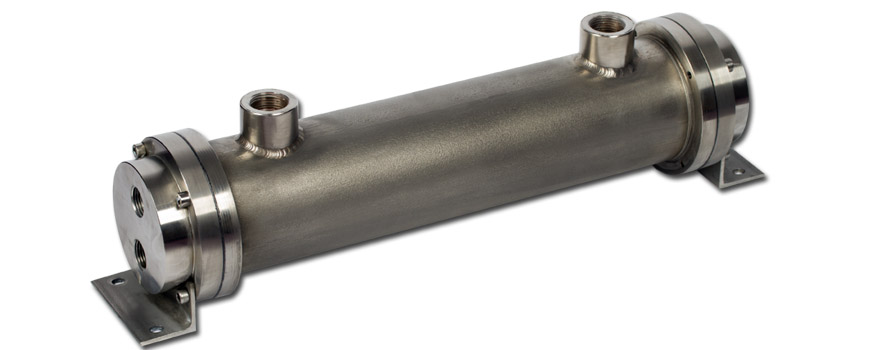In the realm of industrial processes and thermal management systems, heat exchangers play a pivotal role. These ingenious devices facilitate the efficient transfer of thermal energy between two or more fluids, enabling precise temperature control and optimizing energy consumption. Among the various materials employed in their construction, stainless steel stands out as a superior choice, offering unparalleled durability, corrosion resistance, and versatility. This article delves into the world of stainless steel heat exchangers, exploring their exceptional qualities, diverse applications, and the numerous advantages they bring to the table.
The Stainless Steel Advantage
Stainless steel is a remarkable alloy known for its exceptional corrosion resistance and strength. This material’s unique properties stem from its chromium content, which forms a passive oxide layer on the surface, shielding it from the damaging effects of harsh environments and aggressive chemicals. Consequently, stainless steel heat exchangers boast an extended lifespan, minimizing maintenance requirements and reducing overall operational costs.
Moreover, stainless steel’s inherent strength allows for the construction of compact and lightweight heat exchanger designs, making them ideal for space-constrained applications or installations where weight is a critical factor, such as in the aerospace and automotive industries.
Diverse Applications
Stainless steel heat exchangers find applications across a wide array of industries, catering to various thermal management needs. In the chemical and petrochemical sectors, they play a crucial role in facilitating reactions, distillation processes, and the safe handling of corrosive substances. The food and beverage industry relies on stainless steel heat exchangers to ensure precise temperature control during pasteurization, sterilization, and other thermal processes, safeguarding product quality and adhering to stringent hygiene standards.
Furthermore, stainless steel heat exchangers are indispensable in power generation facilities, where they facilitate efficient heat transfer in boilers, condensers, and cooling systems. The automotive industry also benefits from their integration into engine cooling systems, ensuring optimal performance and longevity of vehicle components.
Design Versatility
One of the remarkable strengths of stainless steel heat exchangers lies in their design versatility. Manufacturers can engineer these devices in various configurations, such as shell-and-tube, plate, or compact heat exchangers, tailoring them to specific application requirements. This adaptability allows for optimized heat transfer rates, pressure drop characteristics, and overall system efficiency.
Moreover, stainless steel heat exchangers can be fabricated in a range of grades and alloy compositions, each offering unique properties to cater to specific operational conditions. For instance, high-alloy stainless steels with increased chromium and molybdenum content provide enhanced resistance to localized corrosion and pitting, making them suitable for highly aggressive environments.
Maintenance and Cleanability
Stainless steel heat exchangers excel in terms of maintenance and cleanability, further contributing to their long-term cost-effectiveness. The smooth, non-porous surface of stainless steel inhibits the buildup of fouling deposits, reducing the frequency of cleaning and minimizing downtime. Additionally, stainless steel’s resistance to corrosion ensures that the heat transfer surfaces remain intact, preserving the exchanger’s efficiency over an extended period.
When cleaning is required, stainless steel heat exchangers can withstand various cleaning methods, including mechanical cleaning, chemical cleaning, and even high-pressure water jets, without compromising their structural integrity or performance.
Energy Efficiency and Environmental Benefits
In today’s world, where energy conservation and environmental sustainability are of paramount importance, stainless steel heat exchangers emerge as a powerful solution, offering remarkable energy efficiency and eco-friendly advantages. These ingenious devices not only facilitate efficient thermal management but also contribute to reducing the environmental impact of industrial processes and operations.
Energy Efficiency: The Cornerstone of Sustainable Practices
Stainless steel heat exchangers are designed to maximize heat transfer efficiency, a key factor in minimizing energy consumption. By facilitating the optimal transfer of thermal energy between fluids, these devices ensure that less energy is wasted, resulting in significant energy savings. This increased efficiency translates into reduced fuel consumption, lower operating costs, and a decreased carbon footprint, aligning with sustainable practices and environmental responsibility.
Moreover, the exceptional durability and longevity of stainless steel heat exchangers contribute to their energy efficiency over time. Unlike their counterparts made of less robust materials, stainless steel heat exchangers maintain their performance and efficiency levels for extended periods, minimizing the need for frequent replacements and the associated energy costs.
Reducing Greenhouse Gas Emissions
The energy-saving capabilities of stainless steel heat exchangers directly contribute to the reduction of greenhouse gas emissions. By optimizing thermal processes and minimizing energy losses, these devices effectively lower the consumption of fossil fuels, which are a major source of carbon dioxide (CO2) and other harmful emissions.
In power generation facilities, for instance, stainless steel heat exchangers play a crucial role in improving the efficiency of boilers, condensers, and cooling systems, thereby reducing the overall fuel consumption and associated emissions. Similarly, in industrial processes, their ability to facilitate precise temperature control and minimize energy wastage translates into lower emissions from manufacturing operations.
Supporting a Circular Economy
Stainless steel heat exchangers align with the principles of a circular economy, which emphasizes the responsible use of resources and minimization of waste. Due to their exceptional durability and resistance to corrosion, these devices boast an extended lifespan, significantly reducing the need for frequent replacements and the consumption of raw materials.
Furthermore, stainless steel is a highly recyclable material, allowing for the recovery and reuse of valuable resources at the end of a heat exchanger’s lifecycle. This closed-loop approach not only conserves natural resources but also minimizes the environmental impact associated with the extraction and processing of raw materials.
Promoting Sustainable Manufacturing
The integration of stainless steel heat exchangers into industrial processes contributes to sustainable manufacturing practices. By optimizing thermal processes and reducing energy consumption, these devices help industries lower their overall environmental footprint, aligning with global efforts to mitigate climate change and promote responsible resource management.
Moreover, the cleanability and low maintenance requirements of stainless steel heat exchangers further support sustainable manufacturing. Their smooth, non-porous surfaces inhibit the buildup of fouling deposits, reducing the need for frequent cleaning and minimizing the use of harsh chemicals or abrasive cleaning methods, which can have detrimental environmental impacts.
Stainless steel heat exchangers stand as a shining example of how innovative engineering and sustainable practices can converge to create solutions that benefit both industry and the environment. By maximizing energy efficiency, reducing greenhouse gas emissions, supporting a circular economy, and promoting sustainable manufacturing, these remarkable devices contribute to a greener and more eco-friendly future. As the world continues its journey towards environmental stewardship, stainless steel heat exchangers will undoubtedly play a pivotal role in achieving a more sustainable industrial landscape.
Conclusion
Stainless steel heat exchangers have solidified their position as indispensable components in various industries, offering unparalleled performance, durability, and versatility. Their corrosion resistance, strength, and design flexibility make them the ideal choice for thermal management applications, ranging from chemical processing to power generation and beyond.
As industries continue to prioritize energy efficiency, environmental sustainability, and cost-effectiveness, the demand for stainless steel heat exchangers is poised to grow. Their ability to optimize thermal processes, reduce maintenance requirements, and contribute to a greener future solidifies their status as a crucial component in modern industrial landscapes.
Whether in the chemical industry, food and beverage sector, or power generation facilities, stainless steel heat exchangers stand as a testament to engineering excellence, combining cutting-edge technology with robust construction to deliver uncompromising performance and reliability.



